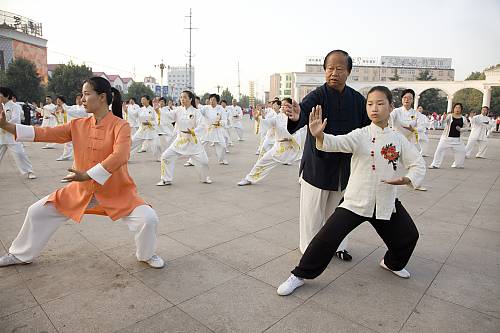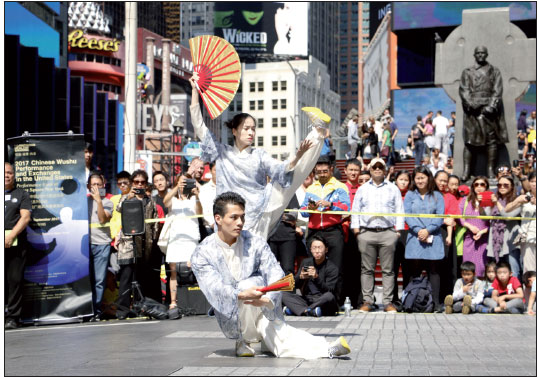NEWS FEATURE
Paris/New York – China waited for 12 years after applying for UNESCO’s World Heritage list for its centuries-old martial art familiarly known as tai chi worldwide and finally was accepted without much fanfare except for the connoisseurs of the physical exercise recognized by health authorities.
The decision on December 18 by the Paris-based UN Educational, Scientific and Cultural Organization put tai chi on the List of the Intangible Cultural Heritage of Humanity. China, with at least 50 UNESCO World Heritage sites, belongs to a handful of countries that have the highest number of such sites. Other countries are France, Germany, Italy, India, Mexico and Spain.
Here is what UNESCO said about tai chi:
“Taijiquan is a traditional physical practice characterized by relaxed, circular movements that works in concert with breath regulation and the cultivation of a righteous and neutral mind. Originating during the mid-seventeenth century in Wenxian County in the Henan Province of central China, the element is now practiced throughout the country by people of all ages and by different ethnic groups.
Taijiquan’s basic movements center upon wubu (five steps) and bafa (eight techniques) with a series of routines, exercises and tuishou (hand-pushing skills performed with a counterpart). Influenced by Daoist and Confucian thought and theories of traditional Chinese medicine, the element has developed into several schools (or styles) named after a clan or a master’s personal name. The element is passed down through clan-based transmission or the master-apprentice model. The latter relationship is established through the traditional ceremony of baishi. Taijiquan has also been incorporated into the formal education system. The element builds upon the yin and yang cycle and the cultural understanding of the unity of heaven and humanity. It has been disseminated through legends, proverbs and rituals, among other vehicles of expression. Safeguarding the element would increase its visibility and dialogue about the diverse ways Taijiquan is practiced by different communities.”

There are an estimated 300 million tai chi practitioners globally. Organizers of tai chi events always delighted at bringing thousands of people together to demonstrate their skills.
Tai chi has a lengthy list of followers, from world models to athletes. But Chinese martial art experts and movie actors like Bruce Lee, Jet Li and Jackie Chan are the biggest promoters of the martial art in movies and educational programs.
Xinhua News Agency said China originally applied in 2008 and was rejected because it was seeking to list Shaolin kung fu, Peking opera and acupuncture in addition to tai chi. UNESCO then limited two requests per year for each country for cultural heritage sites and China revised its applications accordingly. It was reported that China successfully applied in 2011 for Chinese shadow puppetry and in 2013 for Chinese zhusuan, or abacus-based mental calculation.
“Taijiquan is not just a sport to make people fit, but also contains Chinese culture and philosophy,” researcher Yan Shuangjun told Xinhua News Agency. “The application started in 2008, and now we made a victory, which will help this sport to reach more places.”

Xinhua said tai chi has a massive, devoted global following. Millions of elderly Chinese people practice it every day in city parks, and celebrities and other public figures regularly make public references to their practice of it for the health benefits it is said to provide.
According to the Mayo Clinic in the United States, doing tai chi can reduce stress, anxiety and depression, improve aerobic capacity, energy and stamina, enhance the immune system and relieve joint pain.
Xinhua said tai chi originated in the village of Chenjiagou, in central China’s Henan province, in the mid-17th century.

Yoga was inscribed on UNESCO’s Representative List of the Intangible Cultural Heritage of Humanity in 2016.
In 2014 the United Nations proclaimed 21 June as International Yoga Day as the discipline is being followed by hundreds of millions of people worldwide.
UNESCO said describes yoga as “The philosophy behind the ancient Indian practice of yoga has influenced various aspects of how society in India functions, whether it be in relation to areas such as health and medicine or education and the arts. Based on unifying the mind with the body and soul to allow for greater mental, spiritual and physical wellbeing, the values of yoga form a major part of the community’s ethos. Yoga consists of a series of poses, meditation, controlled breathing, word chanting and other techniques designed to help individuals build self-realization, ease any suffering they may be experiencing and allow for a state of liberation. It is practiced by the young and old without discriminating against gender, class or religion and has also become popular in other parts of the world. Traditionally, yoga was transmitted using the Guru-Shishya model (master-pupil) with yoga gurus as the main custodians of associated knowledge and skills. Nowadays, yoga ashrams or hermitages provide enthusiasts with additional opportunities to learn about the traditional practice, as well as schools, universities, community centers and social media. Ancient manuscripts and scriptures are also used in the teaching and practice of yoga, and a vast range of modern literature on the subject available.”

United Nations correspondent journalists – United Nations correspondent journalists – United Nations correspondent journalists United Nations journalism articles – United Nations journalism articles – United Nations journalism articles

